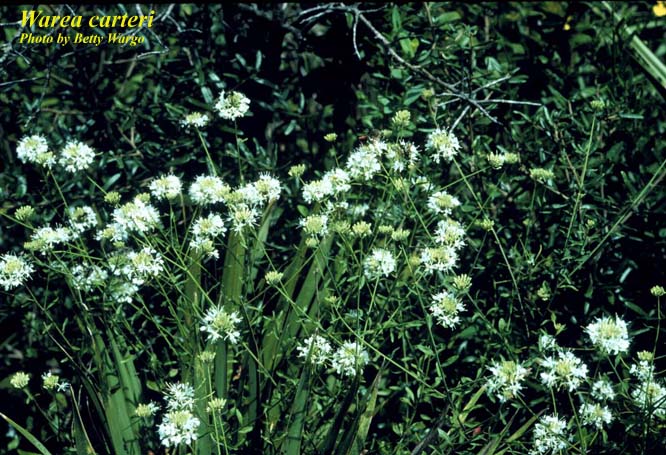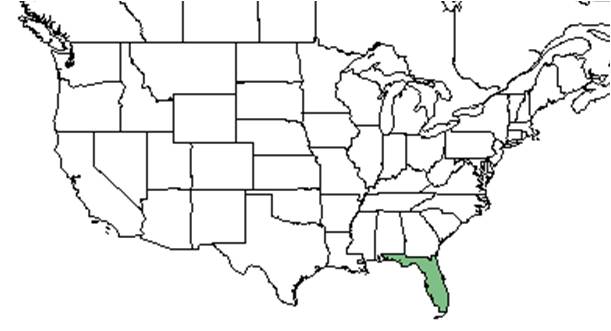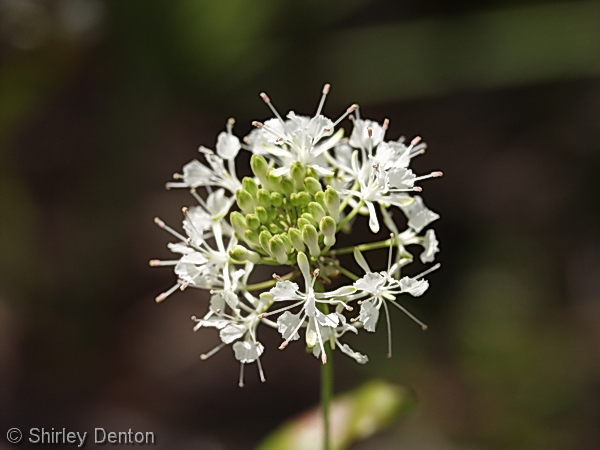Difference between revisions of "Warea carteri"
(→Taxonomic notes) |
(→Taxonomic notes) |
||
| Line 20: | Line 20: | ||
Common name: Carter's pinelandcress | Common name: Carter's pinelandcress | ||
==Taxonomic notes== | ==Taxonomic notes== | ||
| − | ''Warea carteri'' is most similar to ''Warea cuneifolia''. It differs by | + | ''Warea carteri'' is most similar to ''Warea cuneifolia''. It differs by having a stronger pubescence of its petal claws and have always having a white corolla. And it is geographically distinct from ''Warea cuneifolia''. <ref name="natureserve"> [[http://explorer.natureserve.org/servlet/NatureServe?searchName=Warea+carteri]] Nature Serve. Accessed: March 22, 2016. </ref> |
==Description== | ==Description== | ||
Revision as of 20:50, 22 March 2016
| Warea carteri | |
|---|---|

| |
| Photo by Betty Wargo, Atlas of Florida Vascular Plants | |
| Scientific classification | |
| Kingdom: | Plantae |
| Division: | Magnoliophyta - Flowering plants |
| Class: | Magnoliopsida – Dicotyledons |
| Order: | Capparales |
| Family: | Brassicaceae ⁄ Cruciferae |
| Genus: | Warea |
| Species: | W. carteri |
| Binomial name | |
| Warea carteri Small | |

| |
| Natural range of Warea carteri from USDA NRCS Plants Database. | |
Common name: Carter's pinelandcress
Contents
Taxonomic notes
Warea carteri is most similar to Warea cuneifolia. It differs by having a stronger pubescence of its petal claws and have always having a white corolla. And it is geographically distinct from Warea cuneifolia. [1]
Description
A description of Warea carteri is provided in The Flora of North America.
Distribution
Ecology
Habitat
In the Coastal Plain in Florida, W. carteri occurs in sand scrub, Quercus laevis- Serenoa repens communities (FSU Herbarium). This species is endemic to south and central Florida and is found in sandhill, scrubby flatwoods, inland and coastal scrub habitats. [2] The only known populations are in the scrub habitats of the Lake Wales Ridge in Lake, Polk, and Highlands County, Florida. The U.S. Fish and Wildlife Service considers W. carteri to be extirpated in Brevard and Miami-Dave County, Florida. Is commonly found in or near yellow sands. It is also seen in human disturbed areas such as ditches and roadsides. [3] This Warea species tends to grow in full sunlight or light shade areas. Associated species include Pinus clausa, P. palustris, P. elliottii, Quercus laevis, Q. incana, Q geminate, Q. myrtifolia, Q. chapmanii, Carya floridana, Bumelia tenax, Asimina ob ovata, Chionanthus, Lyonia ferruginea, Ilex ambigua, and Serenoa repens. [4]
Phenology
Flowers and fruits in November (FSU Herbarium). Warea carteri seems to be inconspicuous when not in flower. [3]
Seed dispersal
Seed bank and germination
Historically, there were over 200 known patches of Warea carteri on the Lake Wales Ridge but most of the area has been destroyed and converted into citrus groves and residential areas. W. carteri has large population fluctuations associated with fire, such as the population increases a year after a fire and then population decreases the following year. The character of these population fluctuations suggest that seed banks are present. The fruit and seed structures do not have any special characteristics to aid in dispersal. This species can reproduce via selfing (autogamy) which allows contributions to the seed bank after a fire occurs. [5] Seed germination requires moisture and light, flowering is observed from September to October, fruiting is observed from October through November, and seed dispersal occurs in December. [4]
Fire ecology
This species only appears after fire. [2]
Pollination
The following Hymenoptera families and species were observed visiting flowers of Warea carteri at Archbold Biological Station (Deyrup 2015):
Halictidae: Augochlorella aurata, Lasioglossum placidensis
Sphecidae: Ectemnius rufipes ais, Isodontia exornata
Vespidae: Zethus slossonae
Use by animals
Diseases and parasites
Conservation and Management
It has been listed federally as an endangered since January 21, 1987 due to habitat loss and fire suppression. [3] This species is endangered in Florida. To protect this species, land needs to be purchased or a conservation easement needs to be acquired for privately owned sandhill or scrub habitat. Manage these sites with prescribed fires and prevent trampling of habitat. Also eradicate invasive species in the area. [2]
Cultivation and restoration
Photo Gallery
Flowers of Warea carteri Photo by Shirley Denton (Copyrighted, use by photographer’s permission only), Nature Photography by Shirley Denton
References and notes
Deyrup, M.A. and N.D. 2015. Database of observations of Hymenoptera visitations to flowers of plants on Archbold Biological Station, Florida, USA.
Florida State University Robert K. Godfrey Herbarium database. URL: http://herbarium.bio.fsu.edu. Last accessed: November 2015. Collectors: W.P. Adams, Walter M. Buswell. States and Counties: Florida: Dade, Highlands. Compiled by Tall Timbers Research Station and Land Conservancy.
- ↑ [[1]] Nature Serve. Accessed: March 22, 2016.
- ↑ 2.0 2.1 2.2 [[2]] FNAI 2000. Accessed: March 22, 2016.
- ↑ 3.0 3.1 3.2 [[3]] Smithsonian Marine Station at Fort Pierce. Accessed: March 22, 2016.
- ↑ 4.0 4.1 Kral, Robert (1983). “A Report on some rare, threatened, or endangered forest-related vascular plants of the south. Volume 1 Isoetaceae through Eurphorbiaceae. Pages 537-538.
- ↑ Evans, Margaret E. Rebecca W. Dolan, Eric S. Menges, and Doria R. Gordon (2000). “Genetic diversity and reproductive biology in Warea carteri (Brassicaceae), a narrowly endemic Florida scrub annual”. American Journal of Botany, Vol. 87, No. 3: 372-381.
